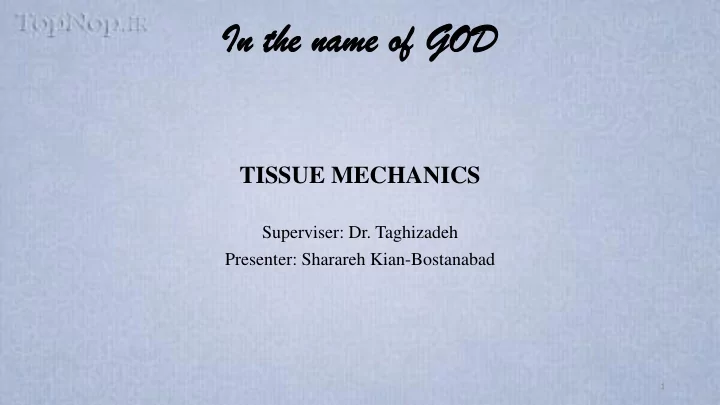

In th n the nam e name of e of GO GOD TISSUE MECHANICS Superviser: Dr. Taghizadeh Presenter: Sharareh Kian-Bostanabad 1
Mass • What is Mass? A non- negative scalar measure of a body’s tendency to resist a change in motion . • The law of Conservation of Mass: Mass can neither be created nor destroyed. 2
Continuity Equation ρ = const Eulerian: or ρ = const or Lagrangian: 3
Example: The velocity of a particle is given as follows: 𝑙𝑦 𝑗 𝑤 𝑗 = 1 + 𝑙𝑢 Get the density of the particle as a function of time. Solve: 𝜖𝜍 𝜖 𝜍𝑤 𝑗 𝜖𝑢 + = 0 According to the law of conservation of mass: 𝜖𝑦 𝑗 𝜀 𝑗𝑘 𝜖𝜍 𝜖𝑤 𝑗 3𝜍𝑙 𝜍 𝑒𝜍 1 3𝑙𝑒𝑢 𝜖𝑢 = −𝜍 𝜖𝑦 𝑗 = −𝜍𝑙 1+𝑙𝑢 = − 𝜍 = − 1+𝑙𝑢 → 𝜍 0 0 1+𝑙𝑢 𝜍 0 𝜍 = (1 + 𝑙𝑢) 3 4
Momentum The basic dynamics principles: Newton’s Laws (force equilibrium and moment equilibrium) Newton’s first low: In an inertial frame of reference, an object either remains at rest or continues to move at a constant velocity, unless acted upon by a force. Newton’s second low: In an inertial reference frame, the vector sum of the forces F on an object is equal to the mass m of that object multiplied by the acceleration a of the object: F = m a. Newton’s third low: When one body exerts a force on a second body, the second body simultaneously exerts a force equal in magnitude and opposite in direction on the first body. An alternative but completely equivalent set of dynamics laws are Euler’s Laws; these are: • More appropriate for finite-sized collections of moving particles • Can be used to express the force and moment equilibrium in terms of integrals • Called the Momentum Principles: The principle of linear momentum (Euler’s first law) The principle of angular momentum (Euler’s second law). 5
The Principle of Linear Momentum • What is Momentum? A measure of the tendency of an object to keep moving once it is set in motion. • 𝑄 = 𝑛𝑤 → F=0 𝑛𝑤 = 𝑑𝑝𝑜𝑡𝑢 • 𝐺 = 𝑛𝑏 The principle of linear momentum, or balance of linear momentum: The law of conservation The rate of change of momentum is of linear momentum equal to the applied force 6
The Principle of Linear Momentum In continuum mechanics: • Linear m omentum → • The principle of linear momentum Principle of Linear Momentum 7
The Principle of Angular Momentum • Angular momentum is the rotational equivalent of linear momentum. • The angular momentum h: • The principle of angular momentum: the resultant moment of the external forces acting on the system of particles, M , equals the rate of change of the total angular momentum of the particles : • In continuum mechanics: Principle of Angular Momentum 8
The Equations of Motion • Cauchy’s law t = σ n acceleration = 0 • The Principle of Linear Momentum • The Principle of Angular Momentum Equations of Equations of Equilibrium Motion 9
Example 2) If 𝜏 𝑗𝑘 = −𝑞𝜀 𝑗𝑘 1) In the absence of body force, does the distribution of the following stress follows equilibrium equations? Where 𝑞 = 𝑞(𝑦 1 , 𝑦 2 , 𝑦 3 , 𝑢) The equations of motion given 2 + 𝑤(𝑦 1 2 − 𝑦 2 2 + 𝑤(𝑦 2 2 − 𝑦 1 as: 2 ) , 𝜏 12 = −2𝑤𝑦 1 𝑦 2 2 ) 𝜏 11 = 𝑦 2 , 𝜏 22 = 𝑦 1 𝜖𝜏 𝑗𝑘 2 + 𝑦 1 + 𝑐 𝑗 = 𝜍 𝑒𝑤 𝑗 2 ) 𝜏 23 = 0, 𝜏 13 = 0, 𝜏 33 = 𝑤(𝑦 2 𝜖𝑦 𝑘 𝑒𝑢 Solve: 𝜖𝜏 𝑗𝑘 𝜖𝑞 𝜖𝑞 𝜖𝑦 𝑘 = − 𝜖𝑦 𝑘 𝜀 𝑗𝑘 = − 𝜖𝑦 𝑗 According to the equations of equilibrium: − 𝜖𝑞 + 𝑐 𝑗 = 𝜍 𝑒𝑤 𝑗 𝜖𝜏 1𝑘 𝜖𝜏 11 𝜖𝜏 12 𝜖𝜏 13 𝜖𝑦 𝑘 = 𝜖𝑦 1 + 𝜖𝑦 2 + 𝜖𝑦 3 = 2𝑤𝑦 1 − 2𝑤𝑦 1 +0=0 𝜖𝑦 𝑗 𝑒𝑢 𝜖𝜏 2𝑘 𝜖𝜏 21 𝜖𝜏 22 𝜖𝜏 23 𝜖𝑦 𝑘 = 𝜖𝑦 1 + 𝜖𝑦 2 + 𝜖𝑦 3 = −2𝑤𝑦 2 + 2𝑤𝑦 2 +0=0 𝜖𝜏 3𝑘 𝜖𝜏 31 𝜖𝜏 32 𝜖𝜏 33 𝜖𝑦 𝑘 = 𝜖𝑦 1 + 𝜖𝑦 2 + 𝜖𝑦 3 = 0 + 0 +0=0 10
Balance of Mechanical Energy 𝑒 𝑒𝑢 • W : work, K : kinetic energy → P = Fv Mechanical Energy Stress Power Balance 𝐿 + 𝑉 = 𝑄 𝐿 + 11 𝑉 = 𝑄 + 𝑅 , 𝜍 𝑣 − 𝜏 𝑗𝑘 𝐸 𝑗𝑘 − 𝜍𝑠 + 𝑟 𝑗,𝑗 = 0 𝑅 = 𝜍𝑠𝑒𝑊 − 𝑟 𝑗 𝑜 𝑗 𝑒𝑇 Energy Equation 𝑊 𝑇
Entropy inequality 𝜍 𝐸η 𝐸𝑢 ≥ −𝑒𝑗𝑤 𝑟 𝜄 + 𝜍𝑟 𝑡 𝜄 • θ : absolute temperature • η : entropy • q : thermal flux vector • 𝑟 𝑡 : internal energy Entropy increase rate in a particle ≥ Entropy enters from the surface boundaries + The total internal entropy of the total volume 12
Boundary Conditions and The Boundary Value Problem • In order to solve a mechanics problem, one must specify certain conditions around the boundary of the material under consideration. Initial Conditions Displacement Boundary Conditions Boundary Conditions Traction Boundary Conditions 13
Boundary value problem ( BVP ) Unknown: • Displacement (in 3 directions) • Stress (6 Components) • Strain (6 Components) Equations: • Equilibrium Equations (3 equations): • constitutive equation (Hooke's Law) → relationship between stress and strain 𝑭 = 1 + 𝑤 𝑤 (𝝉 − 1 + 𝑤 𝜏 𝑦𝑦 + 𝜏 𝑧𝑧 + 𝜏 𝑨𝑨 𝐽) 𝐹 𝑧 Poisson coefficient Modulus of elasticity • Compatibility equations (6 equations) → relationship between strain and displacement 1 𝑭 = 2 (𝛼𝒗 + 𝒗𝛼) 14
Recommend
More recommend